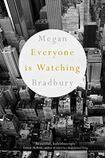
There's something surreal about finishing a new novel by one of my favourite authors and almost immediately beginning another in which that same author features as a character. It feels like something that might take place in a Charlie Kaufman film. And yet that happened to me when I reached the end of Edmund White's Our Young Man and then started Megan Bradbury's Everyone Is Watching, a highly original and elegantly written debut in which White, along with the photographer Robert Mapplethorpe, the poet Walt Whitman and the city planner Robert Moses feature among the main dramatis personae.
Bradbury, a graduate of the creative writing MA at the University of East Anglia (UEA), has created something unusual in Everyone Is Watching and while the separate but connected strands of the story might not be to everyone's taste, they struck me as something more than experimentation for its own sake and as a genuine attempt to evolve the form of the novel while trying to find a new way to tell a person's story.
Although, of course, it’s not a person that she’s writing about at all. It’s a city. It’s New York. A place that has been written about on countless occasions but upon whose streets and across whose avenues the hopes, ambitions, love affairs, artistry and deaths of generations have fallen. It’s a city where a child “can use the narrow gap between two buildings as a safe place to store his treasured possessions”, one that “is not something to be admired from a distance – it is a process”, a skyscraping metropolis where those with a lust for fame or the bodies of beautiful young people can satisfy their hunger.
Central characters
Of the four central characters mentioned above, the most interesting for me was the one I had never heard of, Robert Moses, whose grandiose and self-aggrandising plans for New York dragged it into the 20th century. In doing so, however, he bulldozed the homes of tens of thousands, ignoring the historical rights of citizens and leaving them displaced in an unforgiving city.
Moses is a fascinating oddball, overflowing with ambition but caring nothing at all for the lives he disrupts or destroys. He sees the act of creation as the only reason to stay alive – “Now how can you trust a man who doesn’t create anything?” – and if we learn next to nothing about his personal life, it’s probably because the lives of people who will inhabit the earth for only a short space of time are as nothing compared to the bridges, buildings and walkways that might survive forever. His appearance in this novel is timely, for both his speech patterns and lack of consideration sound like precursors of the delightful billionaire builder Donald Trump. Indeed, when he remarks that “there’s a pathological desire in people to criticise . . . The press criticises because they’re unhappy. Someone should look into their childhoods”, it feels like a phrase that could have come straight out of Trump’s Twitter feed.
Mapplethorpe and White are equally engaging. Although an admirer of both, I knew very little about the photographer’s private life and rather more than I ever wanted to about the writer’s. They provide interesting contrasts in the novel, the former always looking outwards at others, pointing his lens at a sensual landscape of muscles, skin and genitals, while the latter uses his novels and memoirs to stare within, to detail the high and low points of his sex life, always wanting to touch those extraordinary bodies, to penetrate them, rather than turn them into works of art for others to admire.
Authentic voice
Quite what Edmund White will make of this novel is anyone’s guess, but having read most of his fiction and non-fiction, it certainly feels as if Bradbury has created an authentic voice and character, although, of course, whenever a real-life figure appears in fiction, it is not him or her at all, but simply a representation of them, and must be treated as such.
Less successful is the Whitman strand, which lacks the urgency and emotion of the other three. And if there was always to be a quartet at the heart of the novel I would have liked to learn of a New York woman, a Brooke Astor perhaps, an Emma Goldman, a Billie Holiday. Yes, there are sections concerned with Jane Jacobs, the strongest voice in the fight against the megalomaniacal instincts of Moses, and yes, we meet Patti Smith through her relationship with Mapplethorpe, but these women are presented only through their relationships with men. And I could have done without nine pages of acknowledged sources at the end of the book; this is a novel, after all, not a thesis. If the book reads true, then we will believe everything we are told.
That aside, one has to applaud the great ambition of this book. It takes slow, careful reading, with its array of short, Hemingway-esque sentences, staccato phrases and brief chapters, but the effort is well rewarded. There’s a hypnotic effect to the prose and a sense that the author both understands and loves this most complicated of cities.
For decades, the name Bradbury has been associated with UEA through the architect of its famous writing course. Something tells me that Malcolm would be very pleased with his Bradbury namesake and the first fascinating gift she has given us, and that he would be waiting with great anticipation, as am I, for where her extraordinary talent might take her next.
John Boyne's latest work is the short story collection Beneath the Earth (Doubleday)











